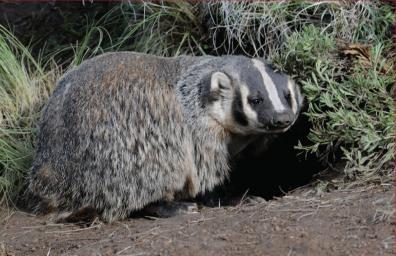A Great Digger- North American Fable
This is an old American fable. It’s not certain who first told it, but it teaches a lesson of importance.
Badger always had a good day—he never complained and always turned a problem into an opportunity. He liked living on the high, dry plains where he had many ground squirrels and prairie dogs as his neighbors. He probably enjoyed their company much more than they did his. If anyone had asked them, they would have said that they wished Badger were somewhere else. He was always disturbing their tranquil community with his daily digging.
Badger wanted to be helpful, and he was—he enabled his neighbors to construct safe homes. They lived in burrows, which are homes under the ground, and creating them is a challenge. Usually the soil is hard and difficult to move, especially below the topsoil. They made their tunnels where he had dug, they were able to dig easily because he had made the soil soft.
Badger was lonely because the other animals never stopped to be with him. They would run and stay inside their burrows shouting, “Watch out, boring Badger is coming.” Badger would try to follow them into their homes for companionship, but the other animals just ignored him.
So Badger just dug and dug all day every day. ”I’m designed for digging,” he said to himself. He had a powerful body: short, stout legs, and big feet, which had long, strong claws. When he started to dig, he could makethe dirt fly.
Badger enjoyed digging so much that he dug countless holes of his own, just for the fun it gave him and how it helped others. More than one fox and coyote had made his home in a hole dug by Badger. They never did take the trouble to thank him though. Instead, they often laughed about his odd way of having fun and commented that Benny must be a stupid fellow.
If they really thought that, they were wrong as well as ungrateful. He was slow and clumsy at everything except digging. He was too heavy and squat to be quick on his feet in order to chase and catch his faster neighbors. That was not because he was not smart. His wits were sharp, he knew he was designed to dig.
Usually, nobody saw Badger until night. He rarely left his den in the daytime, except to sun himself. Then not many noticed him because of camouflage. He did not hide when anyone surprised him while taking a sunbath, but he had a trick of lying flat in the grass without moving, and his striped body blended with the vegetation. So, it took a sharp eye to spy him when he lay low in that fashion.
Sleeping, with his long fur on end, he looked too comfortable to disturb. At least, that was what the ground squirrels thought. And if one of those busy little fellows ever paused to stare at Benny when he was napping in the sunshine, Badger just had to turn his head toward the onlooker. That was sure to make him run away.
One day there was a great wind, a tornado with tremendous force. It blew all the trees away and even removed bushes and grass. The animals all hid in their burrows. When it was calm again, they came out. They said to themselves, it’s a good thing we have our holes to keep us safe. Then they said, “What a difference it makes to have holes for homes. We should thank Badger for doing all that digging.”
He was glad the animals thanked him, they now realized that his help to build their homes had safeguarded them. He would keep digging so that every day was a good one and everyone would have a safe home.
